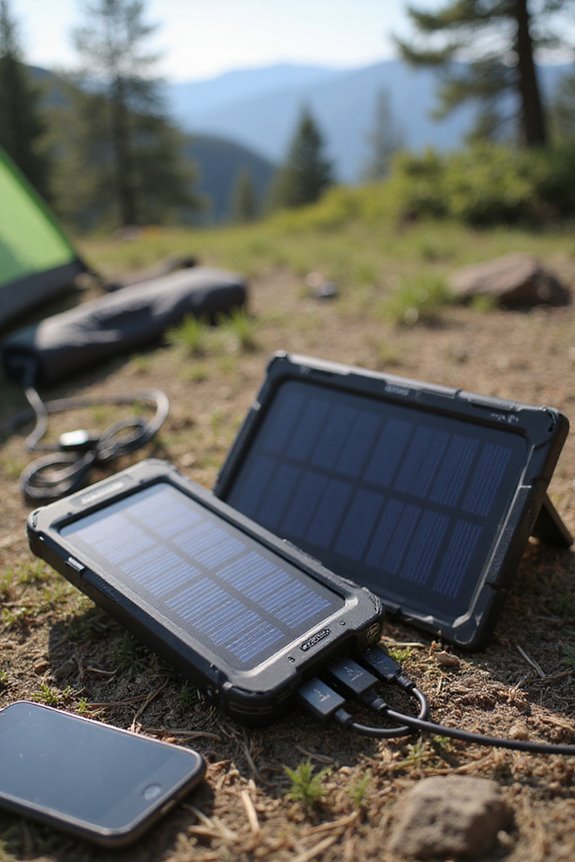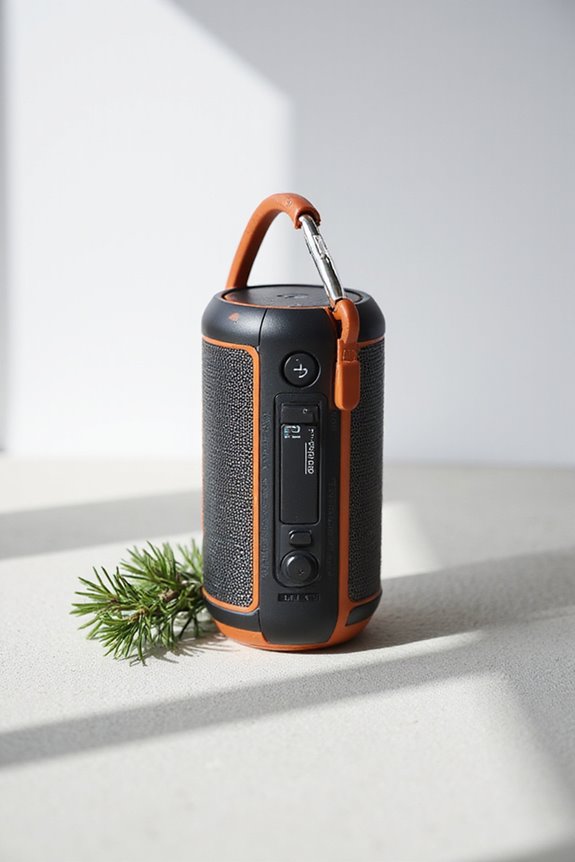Camping doesn’t mean you have to be unplugged! Keeping your devices charged is easy with options like portable power banks, which are compact and perfect for on-the-go energy. Then there are solar chargers, using the sun to juice up your stuff, a great eco-friendly move! For more power, car chargers convert your ride’s battery for device charging. Don’t forget hand crank chargers for those gloomy days! Curious about how to choose the best power bank or mix solar and battery power?
Key Takeaways
- Use portable power banks for quick, on-the-go charging of multiple devices without needing electricity access during your camping trip.
- Bring solar chargers to harness renewable energy, allowing you to charge devices while enjoying the outdoors, especially on sunny days.
- Utilize car power chargers by plugging devices into your vehicle’s DC outlet, ensuring the car is running to avoid battery drain.
- Consider hand crank chargers as a backup option for emergencies, generating power manually when other energy sources are unavailable.
- For larger groups or extended trips, use generators that provide significant power, but be mindful of noise levels in quiet camping areas.
Portable Power Banks: A Convenient Solution
When commencing on a camping adventure, it’s not just the great outdoors that people look forward to; it’s also the thrill of unplugging, even if just for a little while. Enter portable power banks, the unsung heroes of modern camping. These compact gadgets come packed with impressive power bank features, like multiple ports for charging several devices at once, ensuring everyone’s gadgets stay alive. The charging speed is a game changer too—some models, like the NESTOUT, can pump out 32W of power, making sure you’re back online in no time. Plus, their durability means they can weather the elements—waterproof, dustproof, and shock-resistant. So, while nature calls, your devices can still keep up with your adventures!
Harnessing the Sun With Solar Chargers
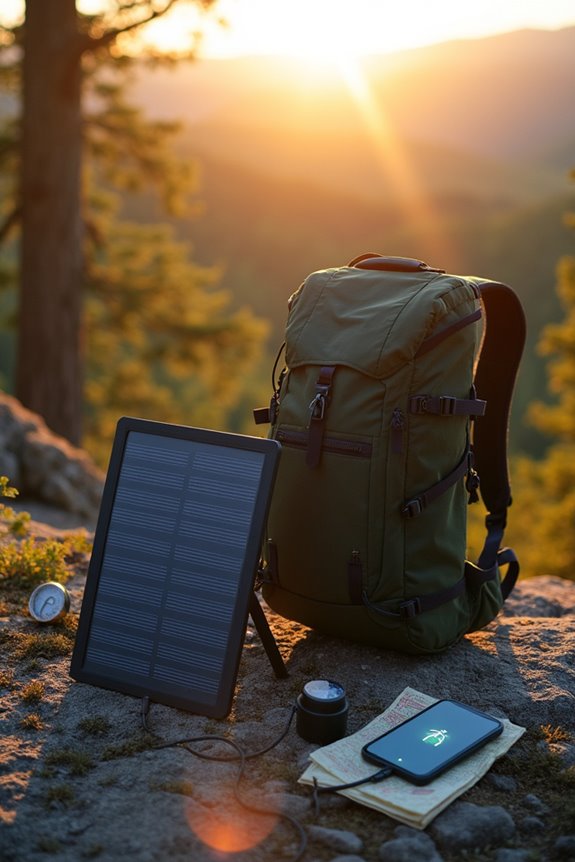
Camping enthusiasts often find themselves torn between the joys of nature and the nagging need to stay connected, which is where solar chargers step in like a trusty sidekick. These handy devices come in various solar panel types, each designed for different needs. From lightweight panels perfect for backpacking to larger models for heavy power demands, the options are plentiful. Charging efficiency can vary too; it’s all about that sunlight! Features like integrated batteries and voltage regulation help store energy and protect devices. Plus, many are waterproof and shockproof, ready for the wild. Imagine setting up your solar charger, soaking in the sun, while your phone powers up, all without a single outlet in sight. Nature and technology can coexist!
Manual Power: The Role of Hand Crank Chargers
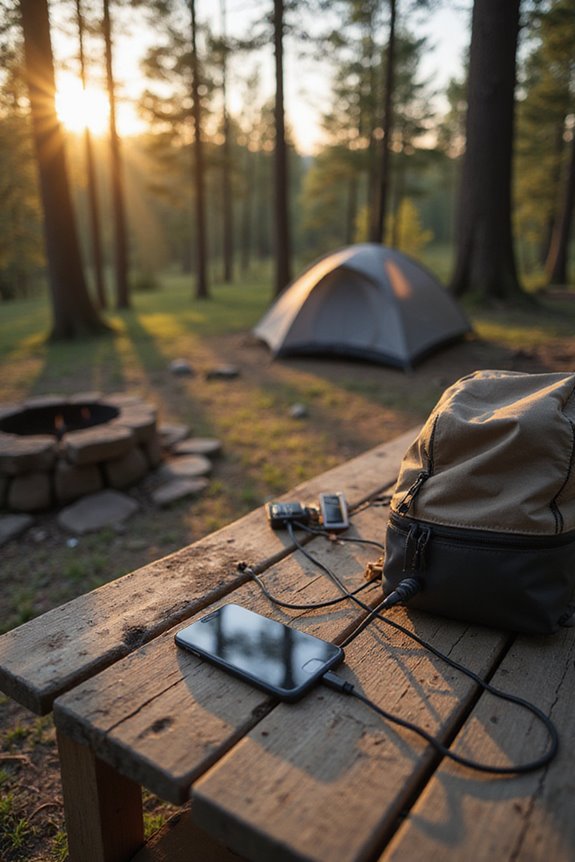
While solar chargers bask in the sunlight, hand crank chargers bring a different kind of power to the table—one that relies on good old-fashioned elbow grease. These rugged, water-resistant devices are perfect for camping trips where the sun might play hide and seek. With a little manual cranking, you can generate enough energy to charge your phone or radio, though it might take a few minutes of effort to see results. They shine brightest during emergencies when other power sources fail. Plus, many models come with built-in LED lights or even radios, making them versatile companions. So, whether you’re off-grid or just seeking a backup, hand cranks are a reliable choice for emergency preparedness.
Utilizing Car Power Chargers for Camping
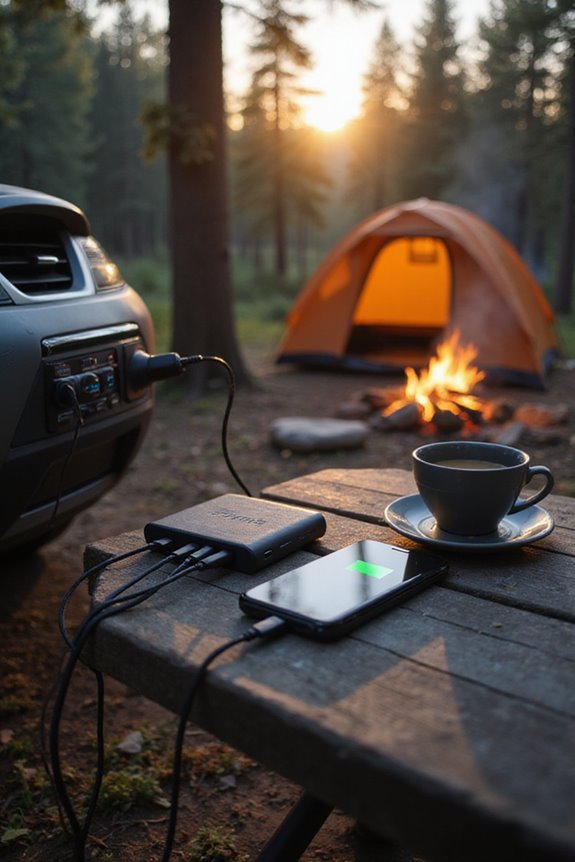
For those who love the great outdoors but can’t bear the thought of being disconnected, car power chargers offer a lifeline that feels almost like magic. With various car charger types available, camping becomes a breeze. Power inverters plug into the car’s DC outlet, giving you multiple USB ports and AC outlets. Portable power stations can also charge while you’re on the move, ensuring you never miss a photo op or GPS turn. Plus, these chargers boast impressive charging efficiency. Whether you opt for dedicated USB chargers or innovative solar hybrids, you’ll keep your devices powered without the hum of a generator. So, pack up those chargers, and enjoy the wilderness without worrying about a dead battery!
Innovative Wood Stove Charging Options
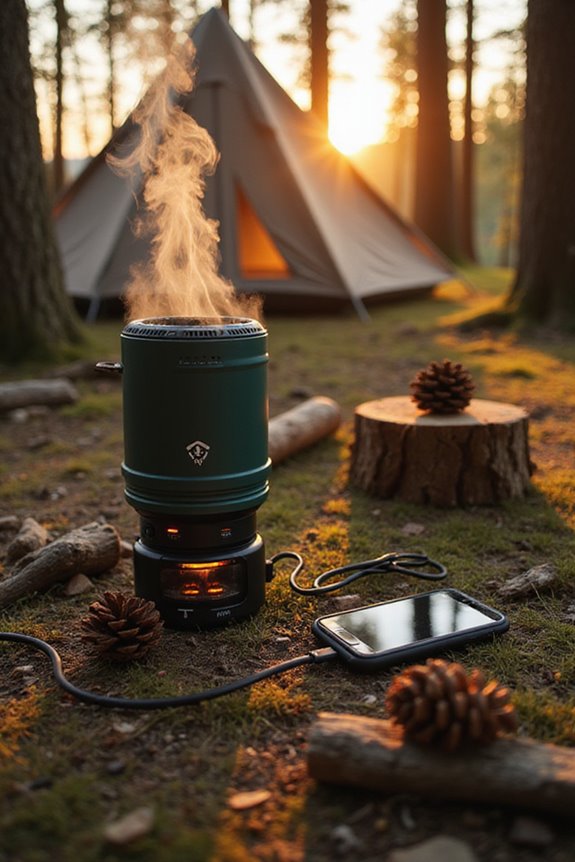
When the crackling of a wood fire mixes with the hum of modern technology, it becomes clear that innovative wood stove charging options are a game changer for outdoor enthusiasts. Take the BioLite CampStove and CampStove 2+, for example—these clever devices harness wood stove efficiency by converting heat from burning biomass fuel into USB charging power. With a nifty onboard battery, the CampStove 2+ can even charge your phone when the fire’s out. Imagine cooking a meal while your smartphone powers up! Just remember, to keep that charge flowing, you’ll need a steady supply of twigs or sticks. It’s eco-friendly, practical, and definitely makes camping feel a little more high-tech!
Cable and Connector Management for Efficiency
Efficient cable and connector management can make or break a camping trip, especially as outdoor enthusiasts increasingly rely on technology. Imagine this: tangled cables, misplaced connectors, and the frustration of trying to charge devices in the wild. To avoid this chaos, cable organization is key. Start by labeling each connector clearly—this makes identification a breeze when you’re racing against daylight. Use zip ties to keep those pesky cables in check, and route them carefully to protect against twists and turns that could lead to damage. Color coding can add a playful touch while enhancing visibility. Regularly check your setup for wear and tear. After all, a smooth camping experience hinges on well-managed cables, letting you focus on enjoying the great outdoors!
Choosing the Right Power Bank Capacity
Choosing the right power bank capacity can feel like maneuvering through a maze, especially when you’re out in the wild and every charge counts. First, tackle your power bank selection by evaluating your devices’ needs. For a weekend camping trip, a 20,000 mAh power bank usually does the trick, providing multiple phone charges. Remember, though, that conversion efficiency hovers around 85%, so adjust your capacity calculation accordingly. It’s essential to confirm compatibility with various devices, from smartphones to tablets. Also, consider the power bank’s durability; you don’t want it breaking during your adventure. Finally, think about future needs—adding a little emergency buffer can save the day. After all, you never know when you might need that extra charge!
Benefits of Fast Charging Technology
Imagine this: after a long day of hiking, capturing breathtaking views with a camera, and traversing through rugged trails, there’s nothing quite like the relief of plugging in your device and watching the battery percentage soar thanks to fast charging technology. The fast charging benefits are undeniable; it can juice up to 80% of your battery in just 45 minutes, slashing downtime. This charging efficiency means you can quickly power up your GPS or camera, keeping you connected and safe in the wild. Plus, portable power stations with fast charging capabilities let you recharge them rapidly, whether from solar panels or your car. With less time tethered to a power source, campers can explore more, ensuring the adventure never stops!
Combining Solar and Battery Power
Camping often calls for a bit of creativity when it comes to keeping devices charged, especially after a day filled with adventure. Combining solar and battery power is a fantastic solution. Lightweight solar panels, like the Goal Zero Boulder 50W, capture sunlight efficiently, turning it into energy. With battery capacity management, like the Yeti 500, campers can store that energy for later use. Imagine charging your phone, laptop, and even a mini-fridge, all powered by the sun! Plus, connecting multiple panels boosts solar panel efficiency, turning a lazy afternoon into a power-generating extravaganza. It’s like having a mini power plant in your backpack, making camping not just fun, but also surprisingly convenient for tech lovers.
Tips for Maintaining Charging Equipment
Maintaining charging equipment can feel like an intimidating task, but with a few straightforward tips, it becomes a breeze. First, store power stations in a cool, dry spot—think of it as their vacation home, away from moisture and rust. Use protective cases to keep them safe from dust and impacts, and elevate them to avoid any water surprises. Regular inspections are key; check for wear and test all ports, just like a car before a road trip. Battery care is essential too—never let them dip below 20% and aim for that sweet 50% charge during storage. Finally, keep an eye on firmware updates, ensuring your power station runs smoothly. With these tips, charging equipment can last through many adventures!
Frequently Asked Questions
How Long Does It Take to Charge Devices Using a Power Bank?
Charging speeds for devices using a power bank depend on the power bank capacity and the device’s requirements. Larger capacity power banks typically charge devices more times but may take longer to recharge themselves.
Can I Charge Multiple Devices Simultaneously With a Solar Charger?
Many solar chargers can support simultaneous charging of multiple devices, especially those rated above 20W. Their efficiency and compatibility depend on factors like sunlight conditions and the types of devices being charged.
What Devices Can Be Charged With a Hand Crank Charger?
Hand crank chargers support various devices, including smartphones and small electronics, though their charging efficiency tends to be low. Users often find them useful for topping off batteries rather than fully charging larger gadgets.
Are There Eco-Friendly Charging Options for Camping?
Eco-friendly charging options include solar panels and portable generators, which harness renewable energy. These solutions reduce environmental impact, providing sustainable power for devices while promoting a cleaner, more efficient approach to outdoor energy needs.
How Do I Ensure My Charging Equipment Stays Dry During Rain?
To guarantee charging equipment remains dry during rain, it is essential to use waterproof bags. This practice enhances charging safety by protecting devices from moisture, thereby preventing damage and ensuring peak performance in wet conditions.

